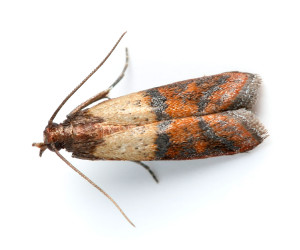Indian Mealmoth
Pest Control: How to Get Rid of Indian Meal moths
- Controlling Indian Meal Moths starts with a careful inspection to identify all the infestation’s food sources
- Empty all of your cabinets and pantries and check inside all food packages. Get rid of any food that is infested. Clean all shelves thoroughly and make sure all holes are sealed
- The use of common pesticides is not advised in treating a moth infestation
- The use of pheromone traps can be used to deal with mild infestations or for monitoring in storage areas.
- Contact Miller Pest Control for professional assistance and expertise
How to Identify an Indian Meal Moth Infestation
- Adults are generally 8 to 10 mm in length with a wingspan of 16 to 20 mm
- The wing colour is usually grey but the rear half of the wing is a rusty brown or nearly bronze
- The larva is generally a cream colour, sometimes with yellowish-green or pink shades, and has a brown head
- The larval and pupal stages are often seen on walls and in areas where the wall and ceiling meet
- The Indian Meal Moth larvae can infest a variety of different dry foods such as dry pet food, birdseed, cereal, dried soup mixes, bread, pasta, rice, flour, spices, dried fruits and nuts
- Most of the damage to dry food products occurs when the larvae spin large amounts of silk that accumulate fecal pellets and cast skins in food products
How to Prevent an Indian Mealmoth Infestation
- Inspect all food products brought into the home; especially pet foods and grain-based products
- Keep dry food products sealed in glass or plastic containers
- Some food may also be stored in the refrigerator
Possible Health Concerns
- Indian meal moths do not sting or bite humans and have not been found to carry disease
- The only danger that comes from Indian meal moths is in eating food that they have contaminated
About Indian Meal Moths
- The Indian Meal Moth life cycle is described as complete metamorphosis; egg, larval (caterpillar), pupal and adult stage
- The entire lifecycle of this species can take between 30 to 300 days
